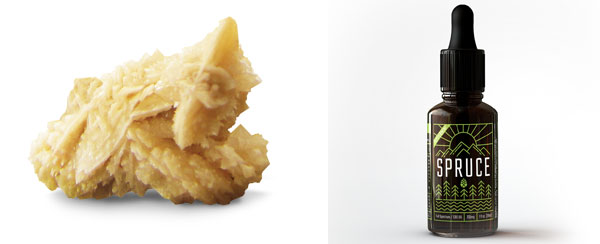Does CBD Oil Work for Kidney Stone Pain?

In the United States, approximately 11 percent of all men and 6 percent of women will experience kidney stones at some point in their lives according to the National Institute of Diabetes and Digestive and Kidney Diseases (NIDDKD). [1]
Furthermore, these yellow or brown pebble-like formations are more common in Americans with a family history of kidney stones or those that have a medical condition that increases their risk of developing stones. This includes those diagnosed with chronic kidney disease, obesity, or repeated urinary tract infections.
Certain medications—like diuretics, calcium-based antacids, and anti-seizure medications—can also cause kidney stones. And if you’ve had them once, you’re more likely to get them again. How do they form?
Kidney Stone Formation
The NIDDKD indicates that kidney stones can form if there are high levels of specific minerals that are present in the urine.
Based on these minerals, the four types of kidney stones are:
- Calcium stones (which includes calcium oxalate and calcium phosphate stones). These are the most common types of kidney stones and occur when your body has extra calcium that is not used by your bones and muscles. Though, eating a high calcium diet does not necessarily mean that you’ll develop calcium stones.
- Uric acid stones. If you eat a lot of fish, shellfish, and organ meat, you may be more prone to developing uric acid stones. Uric acid is also what causes gout, a condition that can cause high levels of pain due to crystals forming around the joints. [2]
- Struvite stones. Struvite stones can occur if you have a urinary tract infection. The NIDDKD states that these particular stones are known for forming and growing rather quickly.
- Cystine stones. This type of stone is more common in people with cystinuria, a genetic condition in which cysteine—which is an amino acid—leaks into the urine.
All four of these types of kidney stones can cause severe pain, particularly if they get stuck in the urinary tract and are unable to pass on their own.
Fortunately, research has found that lab grade, full spectrum CBD (cannabidiol) can help ease this type of chronic pain.
How CBD Works
CBD is one of hundreds of cannabinoids found within the hemp plant, of which tetrahydrocannabinol, or THC, is probably the most well-known. [3] Though, unlike THC, CBD does not create a psychoactive effect.
The endocannabinoid system interacts with cannabinoids, both those made by your body and those ingested via hemp and cannabis substances. These cannabinoids attach to the body’s CB1 and CB2 receptors, resulting in a few rather positive health benefits.
The National Institute on Drug Abuse (NIDA) shares that some of the health benefits provided by the cannabinoids found in medical cannabis and various CBD products include reduced inflammation and individuals having fewer seizures. [4]
For those suffering from kidney stones specifically, CBD can also help provide lower levels of pain. This is critical as many kidney stone sufferers report experiencing excessive amounts of back pain near where the kidneys are located.
Research: CBD for Pain
Research conducted in this area confirms CBD’s positive impact on kidney stone pain and overall kidney health.
For instance, one study published in the American Journal of Physiology-Renal Physiology shares that cannabinoids such as CBD can help improve kidney health by stimulating the CB1 and CB2 receptors. [5]
Another study took an in-depth look at the renal benefits CBD can provide chemotherapy patients, a demographic which is more susceptible to developing toxicity in the kidneys. [6]
In this case, researchers noted that CBD offers an anti-inflammatory effect and decreases cell death in the kidneys while also improving total kidney function.
Proper CBD Dosing
Like with any other health supplement, proper dosing is important when it comes to safe and effective pain management for kidney stones.
According to Medscape, just one dose of CBD “is likely insufficient,” with most therapeutic doses ranging somewhere between 2.85 and 50 mg a day depending on the individual and his or her response to this particular cannabinoid. [7]
However, since cannabis use is now becoming more widely accepted for medical purposes versus strictly for recreational use, Medscape goes on to say that more studies need to be conducted in this area to determine proper dosing for kidney stones and other chronic kidney diseases specifically.
Choosing CBD Product Type
In addition to using the right dose, it’s also important to choose the right CBD product type.
Some of the options in this area include CBD oil and hemp oil, tinctures, sprays, and medical marijuana. It is important to note that medical marijuana also contains THC, so this is something to keep in mind if you want a product that does not offer a psychoactive effect.
That said, some CBD products also contain THC, making it important to know what’s in the products you’re interested in trying for chronic pain relief if you’re concerned about the common effects of cannabis or testing positive on a work-related drug test.
CBD’s Potential for Side Effects
In a Critical Review Report, the World Health Organization (WHO) states that CBD has failed to produce any major side effects when tested in various human studies. [8]
The WHO adds that many open label and clinical trials have also found that this hemp plant cannabinoid “it is generally well tolerated, with a good safety profile.”
In the end, if you’re concerned about whether CBD can help reduce your kidney stone pain safely and without unwanted side effects, you can always consult with medical professionals who are familiar with this cannabinoid and ask them for guidance when making the right decision for you.
This expert can also help you figure out how much CBD you should be taking a day to achieve your desired relief from kidney stone pain.